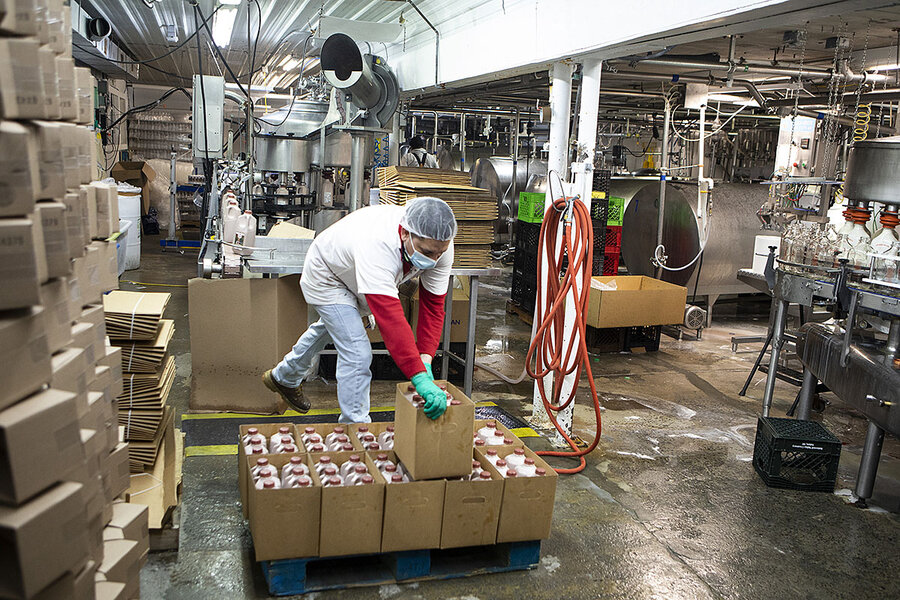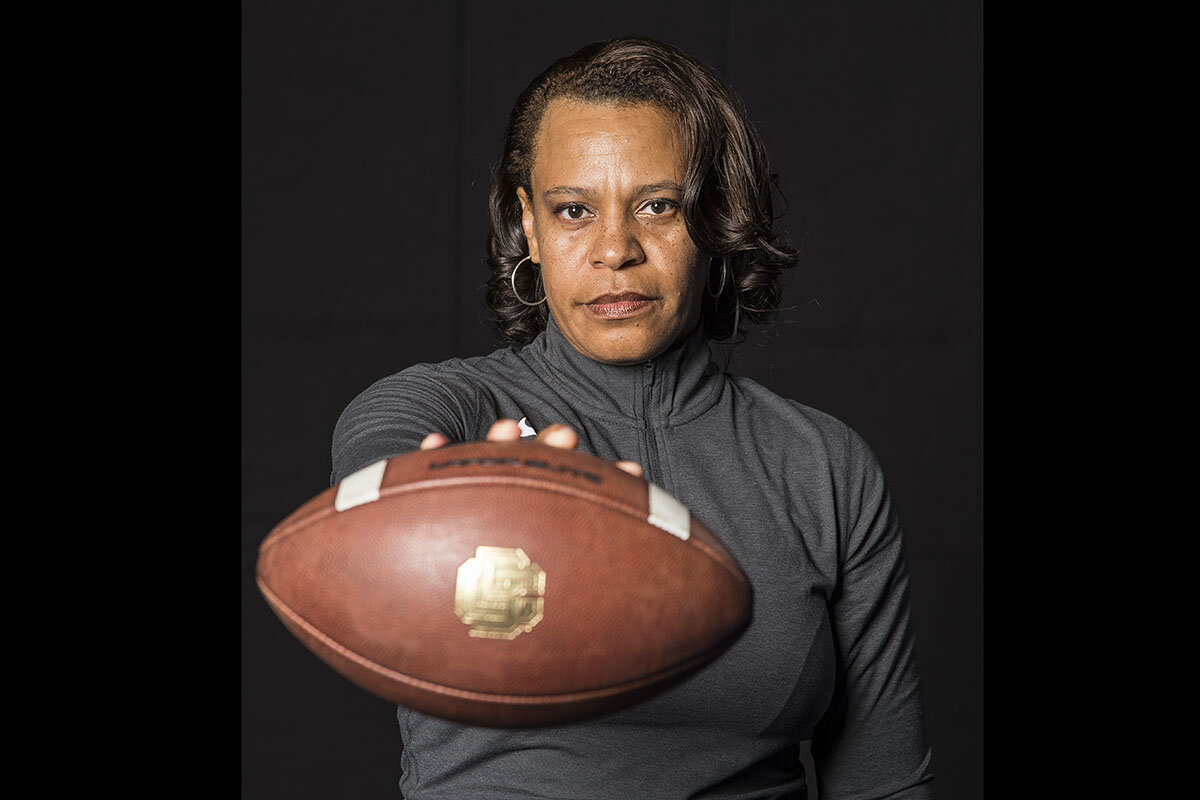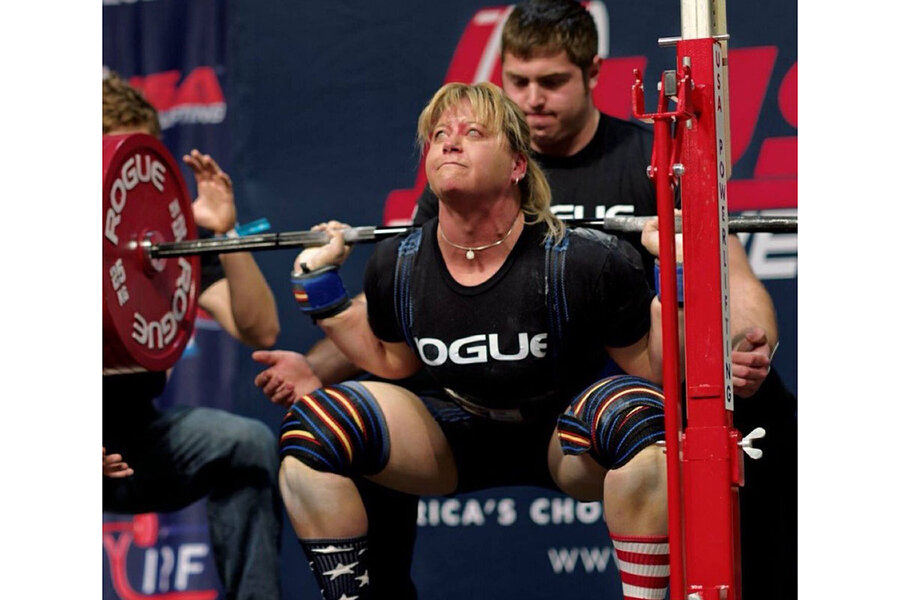- Quick Read
- Deep Read ( 6 Min. )
In Today’s Issue
- To tell the truth? From Armenia to Afghanistan, a new US diplomacy.
- Why California’s governor is facing a recall vote. Three questions.
- Pandemic food lesson: Match struggling farms with hungry people
- Why a Kenyan art exhibit spotlights empty cases
- Women strength coaches do the heavy lifting for women’s athletics
Monitor Daily Podcast
- Follow us:
- Apple Podcasts
- Spotify
- RSS Feed
- Download
TODAY’S INTRO
Find wildlife. Take a picture. Share.
Like a lot of people I’ve been doing a fair number of weekend hikes, but on this past Sunday’s outing I found myself doing something I usually wouldn’t: bending down to turn over a small trailside log.
What for? To see if critters are getting active of course. I was in training, you see. A local nature center was teaching amateurs like me how to be citizen scientists.
“Always roll the log toward you,” the naturalist said, so anything that wants to run away has a clear escape route on the opposite side.
Useful advice anytime. But it might come in handy right away – for me and maybe you too. A worldwide City Nature Challenge is happening from April 30 to May 4, with anyone in participating cities on six continents invited to document the plants, animals, and insects that are living wild there.
Find wildlife. Take a picture. Share.
Those are the basic instructions. For many people this will mean using a smartphone app called iNaturalist that makes the process easy. Online tutorials and pep talks can guide the uninitiated.
The results can end up being used by scientists to track changes in urban environments – valuable alongside other research at a time of significant challenges for biodiversity worldwide. I’m expecting simpler benefits as well, in the joy of observing and learning. Even about things that creep and crawl.
Share this article
Link copied.

Help fund Monitor journalism for $11/ month
Already a subscriber? Login

Monitor journalism changes lives because we open that too-small box that most people think they live in. We believe news can and should expand a sense of identity and possibility beyond narrow conventional expectations.
Our work isn't possible without your support.
To tell the truth? From Armenia to Afghanistan, a new US diplomacy.
Speaking the plain truth is practically synonymous with being undiplomatic. Yet in the realm of U.S. foreign policy, it’s suddenly in vogue. It speaks to a need to focus on what’s important.

From former President Donald Trump’s recognition of Jerusalem as Israel’s capital to President Joe Biden’s use of the word “genocide” to describe the Ottoman Empire’s slaughter of Armenians, truth-telling and debate-ending decisiveness are increasingly carrying the day in U.S. foreign policy.
For President Biden, the willingness to risk the wrath of NATO ally Turkey suggests a determination to put meat on the bones of what he says will be a values-driven foreign policy. Many analysts saw the move as a signal that human rights abuses and authoritarian slides by foes and allies alike are not going to be overlooked.
But for others, what both Mr. Biden’s actions and some of Mr. Trump’s moves suggest is something else: a desire to move the same old time-consuming foreign policy debates off the table to concentrate on a few core issues.
“In the post-Cold War years the U.S. could just dance around a lot of these little things and never make decisions,” says the Wilson Center’s James Jeffrey, a longtime diplomat. “But with both Trump and now Biden there is a shift to recognize the reality of a situation, end the debate with a decision, and move on to what’s really important.”
To tell the truth? From Armenia to Afghanistan, a new US diplomacy.
And another one bites the dust.
By formally recognizing that the atrocities committed against Armenians by the Ottoman Empire more than a century ago constituted genocide, President Joe Biden extends a recent string of actions with which presidents have upended conventional U.S. foreign policy – and predecessors’ caution – to honor a campaign promise.
And perhaps to simply tell it like it is.
The actions range from former President Donald Trump’s recognition of Jerusalem as Israel’s capital to President Biden’s use of the G-word, and from his overruling of the Pentagon to order all U.S. troops out of Afghanistan to even his labeling of Russian President Vladimir Putin as a “killer.” All suggest truth-telling and debate-ending decisiveness are increasingly carrying the day over long-held shibboleths and diplomatic hand-wringing.
For Mr. Biden, the willingness to risk the wrath of NATO ally Turkey and declare as genocide the slaughter of as many as 1.5 million Armenians at the hands of the Turkish state’s predecessor also suggests a determination to put meat on the bones of what he says will be a values-driven foreign policy with human rights as a central priority.
The president made no mention of modern Turkey in his statement Saturday. Still, many analysts saw the move as a signal to the world and to Turkish President Recep Tayyip Erdoğan specifically that human rights abuses and authoritarian slides by foes and allies alike are not going to be overlooked.
But for some diplomats and foreign policy experts, what both Mr. Biden’s actions and some of Mr. Trump’s Middle East moves suggest is something else: a desire to move the same old time-consuming foreign policy debates off the table to concentrate on a few core issues.
“What’s really important”
“With this Armenian genocide declaration and the Afghanistan decision and a few other things, Biden is saying he really does want to skinny down and clear the decks to focus on the big things – climate change, COVID, democracy, China, and Russia,” says James Jeffrey, a longtime diplomat and former special envoy to the Coalition to Defeat ISIS who now chairs the Wilson Center’s Middle East program in Washington.
“In the post-Cold War years the U.S. could just dance around a lot of these little things and never make decisions,” he adds. “But with both Trump and now Biden there is a shift to recognize the reality of a situation, end the debate with a decision, and move on to what’s really important.”

He notes that as President Barack Obama’s ambassador to Turkey, he was privy to the months of debate the former president entertained on the question of whether or not to finally label a “genocide” the atrocities committed against the Armenians.
“As vice president, Biden was there to see how these endless and repetitive debates on everything under the sun by all the top policy makers consumed so much time and attention yet often resolved nothing,” he says. “So Biden wants to avoid that by moving some of the small stuff off the table so he can prioritize what he’s decided really matters.”
And Ambassador Jeffrey says he saw a similar motivation behind some of President Trump’s Middle East actions. “Recognizing Jerusalem as Israel’s capital, but also what he decided about the Golan Heights and the Western Sahara – these are all things that we debated about constantly even though we knew what the reality was.”
After announcing his Jerusalem decision with great fanfare in December 2017, Mr. Trump went on to recognize the occupied Golan Heights as Israeli territory in 2019. Then just before leaving office, he recognized Moroccan sovereignty over the disputed Western Sahara territory.
Signal to China
Still, for some experts the human rights overtones of the Armenian genocide question were at least as important as other motivations Mr. Biden might have had.
Having placed human rights at the center of his foreign policy – and having already deemed China’s treatment of its minority Uyghur population “genocide” – Mr. Biden seemed unlikely to follow in the footsteps of several past presidents who as candidates had promised to describe the World War I-era atrocities against Armenians as genocide, only to back down once in office.
Indeed for some foreign policy experts, the president’s action was at least as much about China as it was about Turkey.
“Yes, Biden was sending a signal to Erdoğan about his anti-democratic actions and growing human rights abuses, but it was also a signal to Russia and what Putin is doing, and perhaps most important of all, to China about its treatment of the Uyghurs,” says Matthew Schmidt, associate professor of national security and political science at the University of New Haven in Connecticut.
“In the case of Turkey, Biden is recognizing a century-old genocide, but in China’s case it’s an active genocide happening before our very eyes,” he adds. “So the more important aspect of calling out the Armenian genocide is not really Turkey, it’s China.”
Like Ambassador Jeffrey, Dr. Schmidt sees a certain determination to “call out things for what they are” in Mr. Biden’s Armenian genocide statement and his willingness to call out human rights abusers more broadly. But beyond simply truth-telling, he sees the president moving to implement what Dr. Schmidt says is the Democratic Party’s “vision of national security that says, the more democracies and the more respect for human rights in the world, the safer America is and the stronger its position in the world.”
Indeed, he sees the influence of Samantha Power, Mr. Biden’s nominee to run the United States Agency for International Development and a longtime Democratic human rights advocate, behind the president’s human rights focus and his willingness to use the word “genocide.”

He notes that Ambassador Power “pushed hard” in the early 1990s for steps to head off the ethnic violence that became the Rwanda genocide, and considered the Clinton administration’s inaction “a shameful blunder.”
“She continued in the Obama administration to promote the idea that getting involved in human rights and calling out abuses is in our interest,” Dr. Schmidt says, “even if sometimes it’s the hard thing to do.”
More to come?
Which is not to say that President Biden tossed all diplomatic niceties to the wind with his Armenian genocide statement.
Soner Cagaptay, an expert in U.S.-Turkish relations at the Washington Institute for Near East Policy, noted on Twitter shortly after the statement was issued that the diplomats who wrote it showed a “mastery” of Turkish politics and history – attributing the genocide to the Ottoman Empire, never once mentioning Turkey, and even referencing Constantinople, the Ottoman capital that is present-day Istanbul.
Moreover, Mr. Biden had even telephoned Mr. Erdoğan the day before issuing the statement to forewarn him that it was coming.
One question now is whether the president has taken all his major get-real-and-move-on actions with the Armenian genocide and Afghanistan withdrawal decisions, or if there are more to come.
Ambassador Jeffrey says he anticipates at least one more high-profile shoe to drop: He predicts the U.S. will be back in the Iran nuclear deal, formally known as the Joint Comprehensive Plan of Action, by the end of May.
“Biden wants to get the JCPOA out of the way, otherwise it drives the whole government and, like these other irritants, takes all the administration’s bandwidth,” Ambassador Jeffrey says. “He knows the JCPOA is only good for five or six years,” he adds, “but it’s five or six critical years he wants to be focusing on these other existential threats.”

The Explainer
Why California’s governor is facing a recall vote. Three questions.
The pandemic upended definitions of successful leadership at all levels. What was once seen as a long-shot bid – recalling California’s governor – is headed for a special election.

- Quick Read
- Deep Read ( 4 Min. )
The tally is in. Opponents of California’s progressive governor, Democrat Gavin Newsom, have collected enough signatures – now verified by election officials – to trigger a recall election of the governor this year. Recall elections in the United States are rare. With 19 states allowing them, this will be only the fourth for a governor in U.S. history.
It’s going to be a biggie, and not just because California is a colossus. This is America’s main electoral event of the year, attracting national attention despite the likelihood that first-term Governor Newsom will prevail in this deep-blue state.
Since 1960, opponents have tried to recall every Golden State governor. They succeeded in getting enough signatures for a special election only once, in 2003, when voters removed Gov. Gray Davis, a Democrat, and replaced him with a Republican, celebrity Arnold Schwarzenegger.
The election is the first big test of how voters are feeling coming out of the worst health crisis in a century. Other governors will be watching.
“Usually, the question that voters ask is, ‘What have you done for me lately?’” says political scientist John Pitney. “The danger for Newsom is that they will pose another question instead: ‘What did you do to me last year?’”
Why California’s governor is facing a recall vote. Three questions.

The tally is in. Opponents of California’s progressive governor, Democrat Gavin Newsom, have collected enough signatures – now verified by election officials – to trigger a recall election of the governor this year. Recall elections in the United States are rare. With 19 states allowing them, this will be only the fourth for a governor in U.S. history.
It’s going to be a biggie, and not just because California is a colossus. This is America’s main electoral event of the year, attracting national attention despite the likelihood that first-term Governor Newsom will prevail in this deep-blue state.
“With special elections, weird things can happen,” cautions Jessica Taylor of the independent Cook Political Report.
Why do some people want to recall Governor Newsom?
Recall efforts are part of California’s political culture, but this one really picked up steam with the pandemic.
Since 1960, opponents have tried to recall every Golden State governor. They succeeded in getting enough signatures for a special election only once, in 2003, when voters removed Gov. Gray Davis, a Democrat, and replaced him with a Republican, celebrity Arnold Schwarzenegger.
The 2020 petition to sack Mr. Newsom was written before the pandemic. It faulted him on immigration, high taxes, high homelessness, and the death penalty. It didn’t gain much traction against a man who won the 2018 election with 62% of the vote.
But voters chafed under months of pandemic lockdown orders, empty classrooms, a clunky start to the vaccine rollout, and massive fraud with unemployment checks. They were particularly incensed when the governor ignored his own safety guidelines and dined with friends at an exclusive restaurant in November. Around the same time, a state judge threw petition-backers a lifeline – a four-month extension to gather signatures due to the pandemic.
“It was all kind of a perfect storm,” says Ms. Taylor.

Why should people outside California care?
The election is the first big test of how voters are feeling coming out of the worst health crisis in a century. Other governors will be watching.
Ms. Taylor believes governors will be judged on two things: vaccine rollout and if schools are reopening. Democrats fought hard to convert suburban women voters during the Trump era. Will they lose them over schools?
Even if schools are back in business in the fall, that may not matter, explains John Pitney, professor of political science at Claremont McKenna College in Claremont, California. This has been a traumatic year.
“Usually, the question that voters ask is, ‘What have you done for me lately?’” he writes in an email. “The danger for Newsom is that they will pose another question instead: ‘What did you do to me last year?’”
Not surprisingly then, the recall is attracting national political attention, money, and involvement from both sides.
What factors will determine the outcome?
There’s a slim chance the recall could be called off if Newsom supporters succeed in getting enough of the more than 1.62 million petition signers to formally change their minds. Assuming that doesn’t happen, voters will face two questions in an election likely to occur between August and December. The first will be “yes” or “no” on recalling the governor. The second question will be who should succeed him if he is recalled. In 2003, that list was long: 135 candidates. Whoever gets the most votes wins.
But as California pollster Mark Baldassare points out, 2021 is not 2003 (though the list could be similarly long). “The successful recall of the governor in 2003 occurred in a very different political context,” he writes in a blog about a March survey by the Public Policy Institute of California, which he leads.
A big difference is that in 2003, the governor was much less popular and the state less blue. Before the recall, Governor Davis had won reelection by 5 points; Governor Newsom crushed his GOP challenger, businessman John Cox, by 24 points. In 2003, Democrats led Republicans in voter registration by 9 points; today, the state is a much deeper blue, with registered Democrats leading Republicans by 22 points.
And back then, 70% of voters disapproved of Mr. Davis, particularly because of rolling blackouts in the state. In the March survey, fewer than half (42%) disapproved of the way Mr. Newsom is doing his job; 40% of likely voters say they will vote to remove him – a safe distance from the majority-vote threshold needed to remove. Meanwhile, 80% of voters said in March that the worst of the pandemic is behind them.
But anything can happen between now and the election – for instance, another record fire season and power outages. The governor just declared a drought emergency in two northern counties.
And of course, there’s the wildcard of the replacement candidates. So far, none of the main GOP candidates has the name recognition of former Governor Schwarzenegger – not former San Diego Mayor Kevin Faulconer, not Mr. Cox, and not former Rep. Doug Ose. But last week, a celebrity candidate jumped in the race: reality TV star, former Olympian, and transgender advocate Caitlyn Jenner, a longtime Republican.
Governor Newsom is already on the attack, tying her in fundraising emails to former President Donald Trump, who is unpopular outside of his base here. She's thin on issues compared to then-candidate Schwarzenegger.
Still, the GOP in California has a history of putting celebrities in political office: Ronald Reagan, Sonny Bono, Clint Eastwood. Could they do it again?

Pandemic food lesson: Match struggling farms with hungry people
When the pandemic struck, a rise in hunger was matched by a surge in farms that lost much of their normal demand. Here’s how one effort to get food where it’s needed may have enduring benefits. Fourth in a series on hunger in America.

- Quick Read
- Deep Read ( 6 Min. )
Across the United States, large food banks were distributing 80% more food in spring 2020 than they had been a year before, as pandemic lockdowns pushed many people out of work. Yet many farms found themselves with unsold food as restaurants or cafeterias closed.
Around the nation, some nonprofits and governments saw opportunities to match unsold crops with people who needed them.
One program called Nourish New York is distinctive as a state-level effort that is poised to continue. Last month, lawmakers in Albany signed a bipartisan bill to put some ongoing state money behind the idea of building connections between food banks and local farms.
“Thankfully, we always had enough,” says program coordinator Mercedes Montero of the food bank Long Island Cares. Even at the height of the pandemic lockdowns, “We never had to close.”
Rick Osofsky, a dairy farmer upstate, says the Nourish program helped stabilize his farm amid worries of a major decline in sales. “We have so much food, and no one should be hungry,” he says.
Pandemic food lesson: Match struggling farms with hungry people
Rick Osofsky walks up to his cows grazing peacefully in the lush field next to the milking barn. He strokes their heads affectionately. This one’s Bella. That one’s Lemon Drop. He knows almost all of his cows by name – and there are around 200 of them.
On the other side of the farm, refrigerated trucks idle outside the manufacturing facilities, where milk is bottled or cultured for yogurt. Farmhands load up the trucks with plastic-wrapped boxes of yogurt, ready to be driven across the country to states as far as California.
It has been a little over a year since the pandemic began, and Ronnybrook Farm Dairy in Ancramdale, New York – against all expectations – is doing better than ever.
Mr. Osofsky is a third-generation farmer and co-owner of Ronnybrook, which has been in his family for 80 years. When the pandemic hit last March, they were anticipating the worst. In New York, schools and other food services, which had constituted about 35% of their sales, had been ordered to close. It had already been hard enough surviving as a small dairy farm due to falling milk prices – across the United States, more than half of licensed dairy farms have disappeared since 2003. And in his own neighborhood, Mr. Osofsky says there were just two of them left, down from about 30 in the 1980s.
Right when farmers were taking a hit, the pandemic was also causing a jump in food insecurity as workers lost jobs and income – and those school closures cast doubt on children’s access to school lunches.
But last April, New York state launched an initiative to connect those dots, linking farmers with food banks, and an infusion of state money to address those twin problems. Some $35 million from the state last year and an additional $25 million this year have helped food banks buy produce from farms including Ronnybrook, and then distribute it to food pantries that serve households in need.
Even in normal times, food banks and pantries face the challenge of being under-resourced. Yet David Just, an agricultural economist at Cornell University, says farm-to-pantry programs like this one and a comparable federal effort called Food Box have been especially helpful during the pandemic.
“Most of the food banks that I’ve talked to say, ‘It’s USDA that saved the day because we could use the cash to order food,’” says Dr. Just, who is currently researching the role of food banks during the pandemic.
Across the U.S., large food banks were distributing 80% more food in spring 2020 than they had been a year before. In New York City, some food banks saw dramatic increases as high as 200%.
That’s not to say the pandemic efforts functioned flawlessly. The U.S. Department of Agriculture (USDA) Food Box program had enough logistical challenges that it’s not being renewed.

But the program called Nourish New York, launched by Democratic Gov. Andrew Cuomo, is seen as having a compelling rationale.
“We have so much food, and no one should be hungry,” Mr. Osofsky says. At his farm, ultimately “instead of having a year where we thought it would be our worst, we had our best.”
Around the nation, nonprofits and governments saw similar opportunities to match unsold crops with people who needed them.
The Nourish program is distinctive as a state-level effort that is poised to continue. Last month, lawmakers in Albany signed a bipartisan bill to make Nourish New York permanent – with the goal of bringing lasting value at a time when food banks say they need support to help the many people who continue to face food insecurity.
“We never had to close”
In New York, what appeared to come together in about a month was really the culmination of years of work, says New York Agriculture Commissioner Richard Ball. Nourish built on other hunger initiatives the state agriculture department had already been running.
For one food bank, Long Island Cares, food distribution almost doubled, from an average of 10 million pounds a year pre-pandemic to about 18 million pounds in 2020. Nourish made it easier to get food, says chief operations officer Peter Braglia.
At one of their food pantries in Freeport on Long Island, program coordinator Mercedes Montero greets clients warmly through a counter window as they enter the modest pantry to pick up pre-packed bags of food on a recent Thursday morning. Some are familiar faces, she says, while others were first-time clients. It was a quieter morning than usual; as businesses slowly reopen across the state, the number of people coming by has been decreasing.
But even at the height of the pandemic, the pantry was able to cope. In March last year, it was serving an average of about 1,000 people a month. By May, that number had hit 3,000. Deliveries increased in frequency and there were days when the freezer would be packed to the brim with frozen meat.
“Thankfully, we always had enough,” says Ms. Montero. “We never had to close.”

Strengthening local networks
The funding from Nourish also allowed food banks to be able to buy more easily from smaller farms while supporting New York food producers. According to a 2019 agriculture state report, small farms make up almost three-quarters of all farms in New York, but accounted for just over 4% of all sales. Large farms – less than 3% – generated over 60% of all sales.
Mr. Braglia says most food banks try their best to buy local as much as possible, but the priority tends to be on getting “the most value for their dollar” because of limited resources. And economies of scale meant it is usually more cost-efficient to buy from larger farms and producers, who weren’t always local.
With Nourish, however, the condition was to “keep it local.” And that’s how Mr. Braglia met Julia Van Loon, the owner of Slate Foods, a consortium of small beef producers in New York.
When schools were ordered to close, Ms. Van Loon’s first thought had been for the students and teachers in the 47 school districts she had been working with through a farm-to-school program. Then her next thought was the 170,000 pounds of beef sitting in a freezer in a warehouse on Long Island. What was she going to do with all that unsold beef? She remembers turning to her husband, asking, “Is this how it ends?”
But within a week of the launch of Nourish, Ms. Van Loon heard from Mr. Braglia at Long Island Cares. By mid-May, she had found a new home for her 170,000 pounds of beef. She was also able to keep her farmers and her business going – while knowing her food was going to a worthy cause.
The Nourish program has created an infrastructure to help bring down transaction costs – a benefit normally associated with scale – and has made the market more inclusive, says Dr. Just. Although government resources will still be needed, “that’s something that could be durable and long lasting, and it creates value ... [that can be] potentially self-sustaining,” he says.
Looking forward
Programs like Nourish aren’t a one-step fix for food insecurity. And participants say there is room for improvement, such as timelier deliveries and reducing backlog.
But they say Nourish has helped build a more resilient regional food system – food banks, distributors, and farms now have new networks they can tap into. And if another crisis comes their way, they are better prepared.
“Hopefully from there, we can unite as a food bank association, maybe do some group purchasing from some of these smaller [farms], give them another outlet. I don’t believe a lot of these farms that we were exposed to had a relationship with any food banks before,” says Mr. Braglia.
One of those new ties is with Ms. Van Loon, whose beef consortium is just a phone call away. “I have all these new relationships I’ve never had before,” she says. “It’s created a new sense of community, which has been missing for a while now.”

Why a Kenyan art exhibit spotlights empty cases
When you walk into a museum, you don’t expect empty cases. But in this exhibit, you do – and that’s the point. It honors the visceral loss of heritage in countries whose art was plundered during the colonial era.

- Quick Read
- Deep Read ( 4 Min. )
In a display hall at the Nairobi National Museum is a piece made up of 2,000 shipping labels. Each one bears data about an object taken from present-day Kenya by Europeans during the colonial period, many of them stolen. But the name of the piece is “31,302”: the number of Kenyan pieces held in European and American institutions, as cataloged by the International Inventories Programme, a Kenyan-European collective.
The collective put together this exhibition, called “Invisible Inventories,” to highlight the tens of thousands of objects plundered from Africa, and examine the legacies of that loss – the holes it has left behind in communities robbed of their heritage.
“Watching people interact with this exhibition, we’re seeing the anger and the pain,” says Jim Chuchu, director of The Nest, an artists’ collective that co-organized the exhibit. Many Kenyans, he says, have never seen this history of dispossession “put on the record.”
The debate about who should be the custodians of Africa’s art and artifacts stretches back more than half a century. But the movement for restitution has garnered renewed momentum.
“The movement is snowballing,” says Souleymane Bachir Diagne, a Senegalese philosopher and professor at Columbia University. “There’s a public pressure now that wasn’t there before.”
Why a Kenyan art exhibit spotlights empty cases

In a display hall at the Nairobi National Museum, a row of glass cases at the center of a new exhibition sits empty.
That’s by design. They display an absence, representing the tens of thousands of objects taken out of present-day Kenya by Europeans during the colonial period – many of them stolen. At least 32,000 of those pieces, including works of art and other pieces of great cultural significance, remain in museums in the Western world, according to a database compiled by the International Inventories Programme (IIP), a collective of Kenyan and European scholars, archivists, and artists.
The group put together this exhibition, called “Invisible Inventories,” to examine what that empty space means – the holes it has left behind in communities and countries robbed of their heritage.
“For us, these missing objects are just the beginning,” says Njoki Ngumi, a member of The Nest, a Nairobi-based artists’ collective that co-organized the exhibition. “They are a symbol of something much larger.”

The debate about who should be the custodians of Africa’s art and artifacts – the countries and communities that produced it, or the Western institutions where as much as 95% of it resides – stretches back more than a half-century, to the era of African independence.
But the movement for restitution of African art has garnered renewed momentum in recent years. In 2018, a report by Senegalese economist Felwine Sarr and French historian Bénédicte Savoy, and commissioned by the French presidency, recommended that France begin repatriating items it had taken without consent during colonial rule. Germany, meanwhile, set up a government office to assist with repatriation, and several European museums have pledged to return their collections of Benin Bronzes, iconic brass sculptures plundered from the Kingdom of Benin in modern-day Nigeria.
“The movement is snowballing,” says Souleymane Bachir Diagne, a Senegalese philosopher and professor of French at Columbia University, who advised Dr. Sarr and Dr. Savoy on their report. “There’s a public pressure now that wasn’t there before.”
But even as conversations and negotiations continue, the absence is still viscerally felt, say the organizers of “Invisible Inventories.”
“Watching people interact with this exhibition, we’re seeing the anger and the pain,” says Jim Chuchu, The Nest’s director. Many Kenyans, he says, have never seen this history of dispossession “put on the record. So this exhibition goes some way to telling people their feelings of loss are valid. It’s OK to feel wronged.”

The empty glass cases form only a small part of the exhibition, which also features works by a wide variety of Kenyan and European artists addressing the legacies of the loss.
One piece, for instance, is made up of thousands of shipping labels strung together, each bearing data about a Kenyan artifact currently held overseas.
The title of that piece, “31,302,” comes from the number of Kenyan pieces held in about 30 European and American institutions that the IIP had cataloged by the time “Invisible Inventories” opened in mid-March. It’s a way, Mr. Chuchu says, of visualizing “each and every object” – except that so many objects were identified that only the labels for around 2,000 could be displayed.
Elsewhere in the exhibition are panels with descriptions and photos of six “objects of national importance” – all of them Kenyan cultural pieces held by overseas museums. They include the Ngadji, a sacred drum of the Pokomo people stolen by a Norwegian wood trader. The drum is held by the British Museum, where it has sat in storage for more than a century, never once put on display.

“The loss that’s been experienced is much larger than just these objects – it’s about a loss of value systems, of history,” says Sam Hopkins, a member of the Shift Collective, a group of European artists involved in the exhibition. “So it’s not just about giving back the objects and saying we’re all square. It’s much more complicated than that.”
After its run in Nairobi, “Invisible Inventories” will be displayed in two museums in Germany, where its organizers hope it will continue to inspire visitors to think about larger questions of loss and redress related to colonialism.
“Colonialism created a global system based on injustice and inequality – how do you right that?” Mr. Hopkins says. “But if you can return objects to communities that need and miss those objects, that’s a clear step and it’s a start.”

Women strength coaches do the heavy lifting for women’s athletics
As female strength coaches command more respect and – slowly – better positions, they’re raising their voices on behalf of women’s collegiate athletics, an important step on the path toward parity with men’s teams.

- Quick Read
- Deep Read ( 5 Min. )
-
By Martin A. Davis Jr. Correspondent
Corliss Fingers, director of strength and conditioning at Bethune-Cookman University, has been breaking barriers throughout her roughly 25-year career. “When I started,” she says, “I was on an island by myself.”
While there has been growth in the number of female strength coaches in collegiate athletics, progress has been slow. In 2012, some 14% of college strength coaches were women. In 2020, it’s still 14%. Between those years, the percentage was never higher than 15.
One of the institutions leading change is Arizona State University, where Liane Blyn is director of sports performance and Olympic sports. Forty percent of her staff is female, something she credits the university for. “We have people who look at the future and want to lead,” she says.
Bringing women on board has distinctive advantages, too, since a significant percentage of college athletes come from single-parent households. “The majority of my players,” says Ms. Fingers, who is Black, “were raised by a strong, Black female. … They get that I’m coming at them from a place of concern.”
Women’s collegiate athletics still have a long way to go before they’re accepted by the general public as on par with men’s athletics, but female athletic trainers are playing a significant role in that transition.
Women strength coaches do the heavy lifting for women’s athletics
A viral Instagram post in mid-March by Stanford University performance coach Ali Kershner quickly became national news. One side-by-side photo showing a well-stocked men’s training facility and a grossly underequipped women’s facility made plain the gross inequalities in the most high-profile college sporting event, the NCAA basketball championships.
“That weekend the story broke,” says Jeanne Rankin, director of strength and conditioning at Eastern Connecticut State University, “I was on my phone pushing stuff out [in response], and I was just exhausted. There’s just constant disrespect toward women’s sports.”
Corliss Fingers, director of strength and conditioning at Bethune-Cookman University, understands the frustration but has a more optimistic view. “I think this is going to be a watershed moment,” she says. These inequalities have “always been there, but every opportunity creates new conversations.”
Increasingly these conversations are being led by female strength coaches like Ms. Fingers and Ms. Rankin. While largely unknown to sports fans, strength coaches are well known to those in a position to shine a brighter light on women’s athletics: male strength and conditioning coaches, athletic administrators, and college athletes.
The impact they’re having is both changing the perception of women’s college athletics and creating opportunities in top-level jobs that could affect the way we view women’s college sports.
“It’s an evolution”
Ms. Fingers has been breaking barriers throughout her career. Following a successful 15-year stint at the University of Maryland, Southern University hired her in 2012 as the first female head strength and conditioning coach for a Division I football program. Today she’s head strength coach at Bethune-Cookman University and recognized nationally by her peers as a role model for the next generation of strength coaches.
“When I started,” she says, “I was on an island by myself. I was a unicorn, and a lot of guys couldn’t handle it.” She was also hesitant to speak out because she was both the only woman and the only Black person on staff.
The NCAA Demographics Database bears that out. In 2012, there were 240 women with the title strength coach across Division I, II, and III schools. By 2020 that number had only grown to 397 across roughly 1,100 schools.
“These are strong people,” says Brian Gearity, director of the sport coaching master’s degree program at the University of Denver. “These women … are totally cognitively loaded, in ways that most strength coaches never have been.”
“It’s an evolution,” says Sandy Abney, chief science officer at the Collegiate Strength and Conditioning Coaches Association (CSCCa) and a former strength coach at the University of Texas.
That evolution has been apparent at the annual CSCCa women’s breakfast meeting. Ms. Fingers remembers when she first started attending in the mid-2000s.
“There were 10 of us,” she recalls. “Now, we’re well over a 100.”

Still, no one is Pollyannaish about the work that lies ahead. “We face lots of challenges,” says Sara Terrell, chair of the National Strength and Conditioning Association’s Women’s Committee and an associate professor of exercise science at Florida Southern College. “Women in [strength] roles have no room for error. They feel they must do more, work harder, and do better.” And while there are more jobs, she adds that many still go to men.
That’s also borne out by the NCAA Demographics Database. Women are being hired as strength coaches, but the percentages are stagnant. In 2012, some 14% of college strength coaches were women. In 2020, it’s still 14%. Between those years, the percentage was never higher than 15.
“We are going somewhere,” says Dr. Gearity, “but slower than it needs to be.” Though he admits the women’s basketball fiasco has called attention to the challenges facing women’s athletics and strength coaches, he worries about the staying power. “People will weather this social media storm,” he says, noting that more fundamental changes need to occur. “Budgets need to change, policies need to change.”
As important, he says, men need to change. “The issue has got to be for men to become more critical and aware of themselves,” he says. Men must be “committed to making organizations diverse and equitable.”
Beyond communication to connection
A couple hundred men had their eyes opened last spring after Ms. Fingers joined a Zoom call hosted by the African American Performance Coaches Association and its founder, SaJason Finley. It was meant to be a time to unite strength coaches as the pandemic was closing the country down. Ms. Fingers, however, felt left out. “We did a little closing prayer,” she says. “It was ‘men this,’ and ‘men that.’”
The email Mr. Finley got from her after the meeting changed his perspective, he says. The two talked the following week. “They’re going through twice as much as we go through,” Mr. Finley says. “We then brought those lessons before a couple hundred performance coaches. We just didn’t know the challenges these women were facing. She’s Mama Fingers to me now. [I’m] excited about how we’re moving forward.”
Ms. Rankin, from Eastern Connecticut State University, appreciates the positive momentum, too. However, “we need more women in charge of Tier I men’s sports,” she says. And we need “more women who are directors.” Currently she counts only about 30 female directors of strength and conditioning in Division I.

Institutional change is happening, though, and Arizona State University (ASU) is one of those leading the way.
Liane Blyn, a championship weightlifter, is director of sports performance and Olympic sports at ASU. Forty percent of her staff is female, something she credits the university for. “We have a great athletic director,” she says. “We have people who look at the future and want to lead.”
Bringing women on board has distinctive advantages, too, since a significant percentage of college athletes come from single-parent households.
“The majority of my players,” says Ms. Fingers, “were raised by a strong, Black female. … They get that I’m coming at them from a place of concern.”
Ms. Blyn agrees. “A lot of it comes down to ego,” she says. “Athletes are willing to trust a female when ego doesn’t get in the way. When you take interest in the athlete as a person and build that connection, that trumps communication. Connection is what I want for you,” she says. And that’s what many female trainers bring. Men tend to stress communication, and that, she explains, is about “what I want from you.”
Women’s collegiate athletics still have a long way to go before they’re accepted by the general public as on par with men’s athletics. Female athletic trainers, however, are playing a significant role in that transition.
For Ms. Fingers, it all comes back to having a voice. “If I don’t agree with something, I use my voice. The more we empower these younger women to use their voices, the more they will be listened to.”
This past March, the NCAA heard one of those voices loud and clear. This time, she wasn’t on an island as Ms. Fingers was 25 years ago. She had a growing force of female strength trainers behind her.
Other headline stories we’re watching
(Get live updates throughout the day.)The Monitor's View
Otherworldly respite in space ventures
- Quick Read
- Deep Read ( 3 Min. )
-
By the Monitor's Editorial Board
“A peep at some distant orb has power to raise and purify our thoughts like a strain of sacred music, or a noble picture, or a passage from the grander poets. It always does one good.”
So wrote John Munro, a British science fiction writer, in “A Trip to Venus” more than a century ago.
Today the world is getting a generous peep at another world: Mars. The unmanned rover Perseverance landed in February and is now preparing to explore its surface, sniffing for signs of life.
Much closer to home on the International Space Station, which orbits above the Earth, the spacecraft Endeavour has made its second voyage to the space station, becoming the first reused craft to travel into space. And don’t forget that, in yet another exploration of our solar system, a NASA probe touched down on the asteroid Bennu in 2020.
It’s true that humanity might be more transfixed by these jaw-dropping distant adventures if it weren’t dealing with the big troubles back here on Earth. But breaking away from those troubles helps put them into perspective. It enables thought itself to break free of its own mental gravity.
Otherworldly respite in space ventures

A peep at some distant orb has power to raise and purify our thoughts like a strain of sacred music, or a noble picture, or a passage from the grander poets. It always does one good.”
So wrote John Munro, a British science fiction writer, in “A Trip to Venus” more than a century ago.
Today the world is getting a generous peep at another world: Mars. The unmanned rover Perseverance landed in February and is now preparing to explore its surface, sniffing for signs of life.
But it’s the little companion Perseverance brought along – a 4-pound helicopter named Ingenuity – that has captured earthlings’ attention. It has made the first powered flight controlled by humans on another world.
Ingenuity has already made three of its scheduled five flights. It’s proving that drones can soar above the Martian surface despite the thin atmosphere (just 1% as dense as Earth’s at sea level).
Perseverance has set an important record of its own: It has separated oxygen from the carbon dioxide in the Martian atmosphere. That will be a crucial capacity needed not only for human explorers but in helping power a spacecraft’s return to Earth.
Controversial entrepreneur and visionary Elon Musk has said he thinks humans will be visiting the red planet in large numbers by midcentury. That’s a mind-boggling thought. It may be easier to grasp what’s happening much closer to home on the International Space Station, which orbits just 260 miles or so above the Earth. Over the weekend, the spacecraft Endeavour made its second voyage to the space station, becoming the first reused craft to travel into space. Reusing both rockets and capsules will decrease costs and increase the frequency with which flights can be made.
The arrival of the four humans temporarily increases the number of people on the space station to 11, just short of the record number of 13. They represent four nations which are cooperating to use the space station: six Americans, two Russians, two Japanese, and one French. For more than 22 years, the space station has acted as a kind of United Nations in the sky, hosting 243 visitors from 19 countries to date. “In this tough situation around the world,” said Japan Aerospace Exploration Agency President Hiroshi Yamakawa in a reference to the pandemic, “I believe you have brought courage and hope for all of us.”
Both Russia and China have expressed desires to launch separate space stations. But the space station remains a key springboard for future missions to the moon and Mars. NASA’s Artemis program plans to send the first woman and the first person of color to the moon and explore new areas of the lunar surface.
And don’t forget that, in yet another exploration of our solar system, a NASA probe touched down on the asteroid Bennu in 2020. The spacecraft collected a sample from the surface and will return it to Earth in 2023.
It’s true that humanity might be more transfixed by these jaw-dropping distant adventures if it weren’t dealing with the big troubles back here on Earth. But breaking away from those troubles helps put them into perspective. It enables thought itself to break free of its own mental gravity.
Inhabiting and investigating other worlds, while at the same time not ignoring earthly needs, is now humanity’s future. Setting limits on what’s possible is never wise.
“The stars will never be won by little minds,” seminal science fiction writer Robert Heinlein once reminded his readers. “We must be big as space itself.”

A Christian Science Perspective
Each weekday, the Monitor includes one clearly labeled religious article offering spiritual insight on contemporary issues, including the news. The publication – in its various forms – is produced for anyone who cares about the progress of the human endeavor around the world and seeks news reported with compassion, intelligence, and an essentially constructive lens. For many, that caring has religious roots. For many, it does not. The Monitor has always embraced both audiences. The Monitor is owned by a church – The First Church of Christ, Scientist, in Boston – whose founder was concerned with both the state of the world and the quality of available news.
Truth you can trust
- Quick Read
- Read or Listen ( 4 Min. )
-
By Tatiana Ogan
If we’re faced with confusion or deceit, it can seem hard to know what truth is. But understanding God’s nature as infallible Truth itself empowers us to discern between what’s true and what’s false.
Truth you can trust
When the noise of opinion is so overwhelming, so loud, we may find ourselves echoing John Lennon’s lyric “All I want is the truth / Just gimme some truth” (“Gimme Some Truth,” 1971). Yet one person’s or group’s “truth” can be exactly the opposite of what another claims as truth. How are we to know what is actually true? Is truth relative, or is there such a thing as absolute, pure truth, independent of opinions?
Mary Baker Eddy, the Discoverer and Founder of Christian Science, was keenly engaged in humanity’s search for absolute truth. Referring to the question a Roman governor put to Jesus, she wrote: “The question, ‘What is Truth,’ convulses the world. Many are ready to meet this inquiry with the assurance which comes of understanding; but more are blinded by their old illusions, and try to ‘give it pause.’ ‘If the blind lead the blind, both shall fall into the ditch’ ” (“Science and Health with Key to the Scriptures,” p. 223).
Truth, one of the synonyms for God taught in Christian Science, is not dependent on opinion, belief, or whim. Opinion is subjective and changeable. Divine Truth is absolute, perfect, loving, and good. It is the ultimate fact-checker. By aligning our thoughts with divine Truth as Jesus did, we can discern and uncover bias, manipulation, hypocrisy, and lies. And we can see them as illegitimate because they have no divine basis or support. The Bible tells us that God is Spirit, and as we yield to the goodness of God’s nature, we can prove our own true nature as God’s children to be wholly spiritual and good and founded securely on divine Truth.
A great example of the power of aligning thought with Truth is a Bible story about a Jewish leader called Nehemiah who inspired the people of Jerusalem to rebuild the wall of their city. This worthy, God-directed project met with intense opposition. Enemies ridiculed those working on the wall, made plans to attack, and spread a rumor that Nehemiah intended to rebel against the king. When that didn’t stop the work, they attempted to distract Nehemiah by urging him to meet with them – an invitation he wisely refused. Finally, they plotted to deceive and lure Nehemiah into hiding, which would likely have eroded the people’s trust in him and kept the nation in chaos and fear – just what his enemies wanted.
In each situation, however, Nehemiah’s spiritual intuition, discernment of Truth, and trust in his God-governed purpose protected him and kept him from being manipulated or intimidated. The wall and gates were finished successfully.
There’s a Bible verse that describes the nature of what divine Truth communicates to us: “The wisdom that is from above is first pure, then peaceable, gentle, and easy to be entreated, full of mercy and good fruits, without partiality, and without hypocrisy” (James 3:17). Pure, peaceable, and gentle Truth is not perceptible to the physical senses, which are consumed with their own dialogue and material viewpoint. When we are faced with lies, it is important to recognize that the fundamental issue is impersonal. It isn’t people lying versus people telling the truth, but rather lying material sense saying that God made good and evil personalities versus spiritual Truth declaring each one’s true identity to be the image of Spirit, divine good.
When I was growing up, I heard conflicting testimony from two people close to me. I knew that one of them had to be lying and the other telling the truth, but as a child, I didn’t know which was which. At one point I became angry and hateful toward one of these individuals, which felt unnatural and uncomfortable – hardly “pure,” “peaceable,” and “gentle”!
As I continued to grow in my understanding of Christian Science, though, I began to notice actions more than words. I discerned honest speech backed up by honest living. I realized I’d fallen into the trap of thinking exactly the opposite of what was true about a loving and strong person. Affirming the fact that God is Love itself reestablished my love for this individual and dissolved the mental fog that had hidden the truth. The lie – along with the fear, confusion, and anger it tried to instill – proved to be powerless against the omnipotent, healing light of divine Truth and Love.
If we are faced with turmoil, confusion, uncertainty, or deceit, we can humbly listen to divine Truth speaking above the arrogance of opinion and the ignorance of blind belief. And we can trust that we are all able to discern between right and wrong, because we are all children of God, children of Truth.
Adapted from an article published in the April 12, 2021, issue of the Christian Science Sentinel.

A message of love
Moonlight grazing

A look ahead
Thanks for joining us today! Tomorrow, Scott Peterson will examine what lies in store for Afghanistan if the long-exiled Taliban retake power after 20 years and try to rule as they did before.




